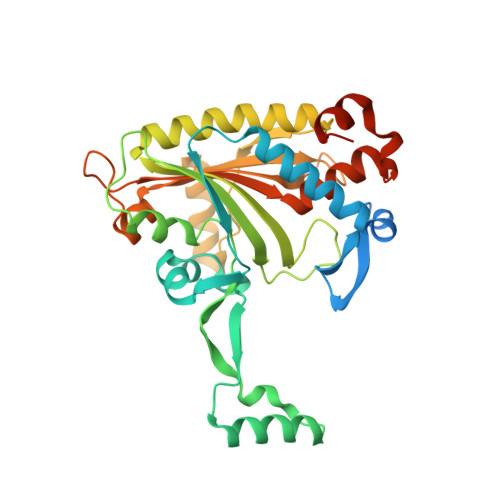Homologs of aminoacyl-tRNA synthetases acylate carrier proteins and provide a link between ribosomal and nonribosomal peptide synthesis
Mocibob, M., Ivic, N., Bilokapic, S., Maier, T., Luic, M., Ban, N., Weygand-Durasevic, I.(2010) Proc Natl Acad Sci U S A 107: 14585-14590
- PubMed: 20663952
- DOI: https://doi.org/10.1073/pnas.1007470107
- Primary Citation of Related Structures:
3MEY, 3MF1, 3MF2 - PubMed Abstract:
Aminoacyl-tRNA synthetases (aaRSs) are ancient and evolutionary conserved enzymes catalyzing the formation of aminoacyl-tRNAs, that are used as substrates for ribosomal protein biosynthesis. In addition to full length aaRS genes, genomes of many organisms are sprinkled with truncated genes encoding single-domain aaRS-like proteins, which often have relinquished their canonical role in genetic code translation. We have identified the genes for putative seryl-tRNA synthetase homologs widespread in bacterial genomes and characterized three of them biochemically and structurally. The proteins encoded are homologous to the catalytic domain of highly diverged, atypical seryl-tRNA synthetases (aSerRSs) found only in methanogenic archaea and are deprived of the tRNA-binding domain. Remarkably, in comparison to SerRSs, aSerRS homologs display different and relaxed amino acid specificity. aSerRS homologs lack canonical tRNA aminoacylating activity and instead transfer activated amino acid to phosphopantetheine prosthetic group of putative carrier proteins, whose genes were identified in the genomic surroundings of aSerRS homologs. Detailed kinetic analysis confirmed that aSerRS homologs aminoacylate these carrier proteins efficiently and specifically. Accordingly, aSerRS homologs were renamed amino acid:[carrier protein] ligases (AMP forming). The enzymatic activity of aSerRS homologs is reminiscent of adenylation domains in nonribosomal peptide synthesis, and thus they represent an intriguing link between programmable ribosomal protein biosynthesis and template-independent nonribosomal peptide synthesis.
- Department of Chemistry, Faculty of Science, University of Zagreb, Horvatovac 102a, 10 000 Zagreb, Croatia.
Organizational Affiliation:


















